Planning and alignment
Improve student engagement and learning by aligning intended learning outcomes, activities, and assessments across courses and programmes.
Aligning intended learning outcomes, assessment tasks and practices and learning activities across courses and programmes helps scaffold students’ development of skills towards professional and personal capabilities. Taking an overview of assessments across the course and programme can help:
- Identify what intended learning outcomes and graduate capabilities are not being adequately prepared or assessed for, or when there is unnecessary repetition.
- Improve student engagement by providing transparency of what they are learning and why.
- Support a better student learning experience by providing opportunities for a steady progression and development of students’ capabilities and skills.
- Reduce over-assessment, making workloads more sustainable for both students and staff.

Small steps
Planning and aligning assessments takes an investment in time and effort to co-ordinate across multiple courses and teaching teams. However, here are some first steps to begin the process:
At course level
Consider how intended course learning outcomes link to graduate profile capabilities.
Ensure course learning outcomes clearly indicate how students can demonstrate they have achieved the learning outcome. This makes it easier to design assessment that allows those learning outcomes to be measured.
Map course learning outcomes with assessments to ensure they are covered adequately.
Map your assessments and learning activities in your course to ensure students have enough time to practice skills and apply their new knowledge before they are assessed on it. This is also a helpful exercise that allows you to see the spacing of assessment deadlines and whether students are being over-assessed.
At programme level
Map programme learning outcomes with all assessments across courses to ensure they are covered adequately by the end of the programme.
Map assessment due dates across all courses in a programme to ensure there are no big clusters where assessments are due at the same time. Use this course map template to help you.
Planning and alignment in practice
Redistributing assessment workload for student wellbeing and greater engagement
Ruth Lemon has started reorganising the teaching and assessment schedules of courses, to reduce student workloads and stress for better student wellbeing.
Supporting students’ intrinsic motivation through enabling choice in DANCE 101G assessments
Alys Longley provides choice and authenticity in assessment for DANCE 101 in order to engage students’ intrinsic motivation and interest.
Curriculum mapping in Business and Economics’ first-year undergraduate core courses
Using curriculum mapping to maintain coherence across an interdisciplinary core and create a consistent student experience.
In depth
At course level
Planning and aligning assessment tasks and practices start with writing strong, measurable intended learning outcomes that link well to the graduate profile capabilities. This will help you identify what students will need to be able to demonstrate (and how) in order for you to know they have successfully achieved the learning outcome.
Early on, students should be given low-stakes/ungraded opportunities to practice (and fail, in a safe environment) their new skills and knowledge. They should also receive timely and constructive feedback before they face (summative) assessment tasks that grade what they have learned.
It is helpful to map your learning outcomes, learning activities, and assessments tasks throughout your course to identify any gaps, unnecessary repetition, or areas where students may be overloaded. Use this course map template to help you.
Professors Chris Rust and David Boud (University of Wollongong) discuss the assessment and feedback principle of ‘aligned’.
At programme level
Ideally the assessment plan will be devised across all courses in a programme to build student capabilities incrementally across courses. But while this is not always feasible, a course assessment plan should be reviewed against other courses in the programme to ensure alignment throughout.
Things to consider when reviewing assessment plans:
- How assessments align and scaffold students’ development of capabilities in their courses and programmes, e.g. intended learning outcomes, professional capabilities, Graduate profile capabilities, and other personal skills necessary to support students in becoming “skilled and flexible” lifelong learners.1
- The timing, weighting, and volume of assessments across courses and programmes of study to ensure the spread of assessment is sustainable for both student and teacher workloads.
- The nature of assessments, moving away from high-stakes end of course summative assessments (such as closed-book exams), towards more formative and continuous assessment that is more relevant to authentic work/community experiences.
- Where feedback occurs, and how timely it is to ensure students are able to understand and use it for their future assessments. Incorporate and use opportunities for feedback in assessment as a mechanism for learning within and across courses.
See also
Student workload calculator
Try out our free online planning tool for estimating your students’ time commitment to attend scheduled sessions and complete assessment tasks.
Graduate profile capabilities
Refresh your memory of the capabilities that we aspire in our graduates.
Rethinking Assessment
Explore alignment and progression in more detail including writing effective learning outcomes.
Page updated 20/02/2025 (added link to student workload calculator)
- Boud, David. “Sustainable Assessment: Rethinking assessment for the learning society.” Studies in Continuing Education 22, no. 2 (2000): 151-167. doi:10.1080/713695728. ↩



